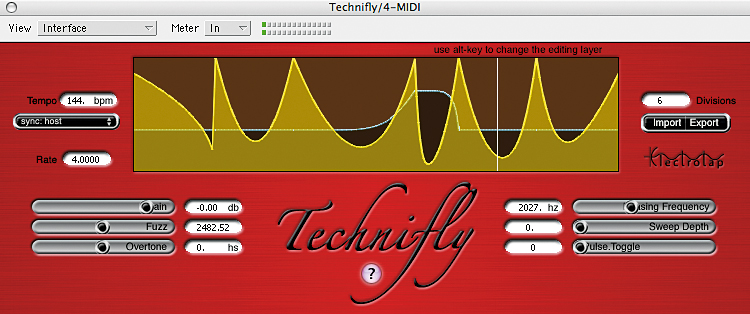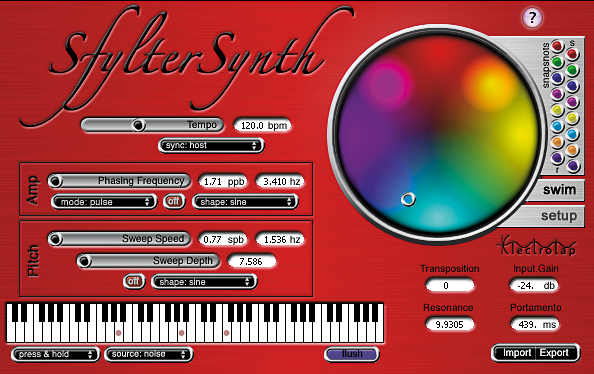MusicRadar Verdict
A defiantly non-standard plug-in collection, Hipno's great if you want to step outside your comfort zone.
Pros
- +
Capable of wild sounds. Deep modulation features. Innovative control. Exploring advanced sound techniques is easy XML import/export for portable presets.
Cons
- -
MIDI assignments tricky. Max users limited.
MusicRadar's got your back



Cycling ´74 call their Hipno collection ‘subversive´ and ‘hell-raising´, and the 43 included plug-ins certainly live up to their billing. With wild, unpredictable granular effects, spectral sonic processors, filters and delays, half a dozen bizarre-sounding synths, and control via colour palettes and even webcams, this is hardly a conventional plug-in pack.
If you´ve been hungering for some ‘out there´ sounds but have been intimidated by software like Max/MSP (with which Hipno was developed), this could be the bundle for you. The challenge for Hipno´s designers? Make this collection as flexible and controllable as Max, but accessible enough to encourage experimentation.
All of Hipno´s 43 effects and instruments run as standard plug-ins -- no additional software or knowledge of Max/MSP is required. If you´re a loyal Max user, you can use the Hipno effects as plug-ins (via the VST object), but not as objects or patches. This, however, is a collection that´s aimed more at non-Max users, though if it does inspire you to try creating your own plug-ins, you should check out Tap.Tools by Hipno´s developer, Electrotap. This features many of the objects that were used to create Hipno, including those used for video input and analysis.
The software can be authorised either via an iLok hardware key, if you own one, or challenge-and-response PACE authorisation.
The plug-ins
Pluggo (one of Cycling ´74´s previous plug-in collections) featured more than 100 plug-ins, but they were a bit hit and miss. Some were brilliant, some were bizarre, and some were garbage. Hipno is different -- each effect is carefully thought out and contains something to get you interested. You´ll want to spend a bit of time with each plug-in, as after some careful experimentation, the ugly, inscrutable effect you first discovered can end up producing a delicate, unexpected result.
Even a single preset can produce wildly different sounds, depending on your source material, though some of these sounds are definitely an acquired taste. Of course, hunting through the plug-ins to try and find something you love is half the fun, and once you do discover one that satisfies, you could easily lose yourself in it for an evening.
Want all the hottest music and gear news, reviews, deals, features and more, direct to your inbox? Sign up here.
While some of the effects in Hipno are quite similar, there´s a fair range of different processors here. There are three basic categories: granular effects, spectral processing and, more generally, delay/filter effects. You can produce some exotic textures with the contents of all three categories, from resonant-sounding drones, to digitally-distorted mangling, to rhythmic, chopped patterns.
In addition, there´s a series of MIDI-controlled synths that build on the ideas of the effects. The SfylterSynth is one of the best of these -- it´s a MIDI-controlled filter effect that enables you to turn one of the nicest filters in the Hipno arsenal into an instrument. Another sure-fire favourite is the analogue-sequencing Technifly, which produces fantastic and bizarre analogue pattern sounds.
Soundscapes
If you want to create arhythmic, droning soundscapes, all of these effects have independent tempo controls. Stack several together, try modulating and randomising parameters, and you can create boundless random sound worlds. But this isn´t just a collection for the ambient avant-garde: if beat-synced, grooving sonic exploration is more your thing, nearly all these settings can be slaved to host tempo, too.
With all these spectral, delay, and granular effects, tiny parameter changes can have a profound impact on the sound. The Hipnoscope Interpolator, which is included in many of Hipno´s effects, can help you to explore these subtleties. Different presets are mapped as spots of colour on a circle, and Hipno interpolates between these presets (as indicated by the shades of colour). You can ‘swim´ through sound settings by dragging an on-screen ‘puck´ or by mapping modulation (see the Hipno Triggers boxout).
Setting up your own colour palettes is a little clunky, but worth the effort. You can set your own preset values and move and resize the splashes of overlapping colour. It´s a terrific sound discovery tool, though you´ll probably want to spend some time adjusting individual faders the old-fashioned way, too.
Whether the Hipnoscope is available or not, Hipno is very flexible in terms of what you can do with presets. You can randomise and ‘evolve´ presets by Cmnd/Alt-clicking the interface, and you can copy and paste settings from presets. It´s even possible to export and import editable XML preset files between different Hipno plug-ins in different hosts, or to share with other Hipno users. All of these features make Hipno a model that other plug-in developers -- whether they´re working on experimental or non-experimental software -- should follow. Our only gripe is that you can´t type numeric values into faders.
Sonic possibilities
Hipno is not for the faint-of-heart. Setting up your modulation options is powerful but tricky, and the plug-ins often sound bizarre and produce unpredictable results. But that´s exactly why adventurous types will love this collection. You won´t find such a broad sonic landscape anywhere else at this price, and by packaging these sounds in flexible, innovative user interfaces, Cycling ´74 have given brave musicians of every persuasion a plethora of sonic possibilities to discover.
MusicRadar is the number one website for music-makers of all kinds, be they guitarists, drummers, keyboard players, DJs or producers...
- GEAR: We help musicians find the best gear with top-ranking gear round-ups and high-quality, authoritative reviews by a wide team of highly experienced experts.
- TIPS: We also provide tuition, from bite-sized tips to advanced work-outs and guidance from recognised musicians and stars.
- STARS: We talk to musicians and stars about their creative processes, and the nuts and bolts of their gear and technique. We give fans an insight into the craft of music-making that no other music website can.
